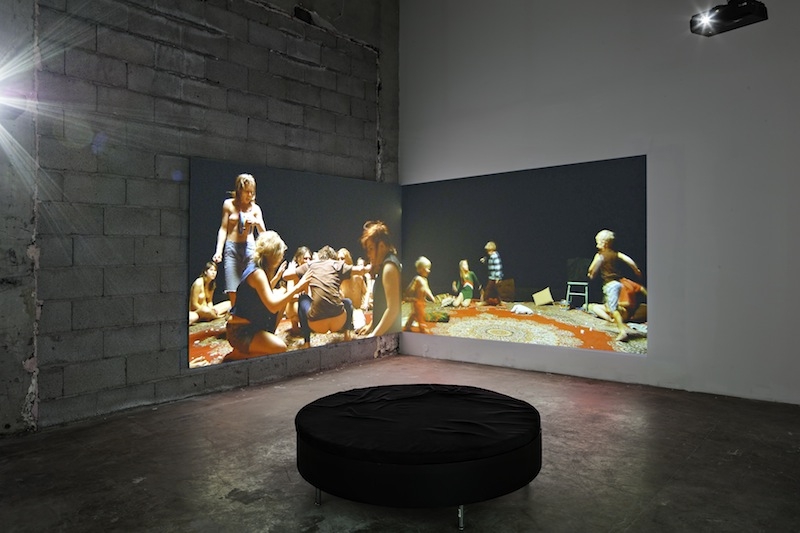Ernesto Sábato’s novel The Tunnel (1948) opens with the confession of Juan Pablo Castel, a socially isolated painter, who admits to having murdered his lover. The ultimate unreliable narrator, Castel takes the reader through the unfolding events, from the beginning of his obsession for Maria (his lover), to the final ending, via a neurotic, circular narrative. Along the way, he spins a tale of justification, obsession and paranoia, dragging the reader with him as he gradually falls deeper into a tunnel of madness and delusion.
Obsessive and paranoid behaviours as a result of social reclusion are some of the aspects explored via the highly idiosyncratic perspectives of the 25 artists and collectives whose work is gathered under the title Tunnel Vision – designating the loss of peripheral vision – for Momentum 8. Less existential than Sábato’s symbolism – ‘a single tunnel, dark and solitary: mine, the tunnel wherein passed all my infancy, my youth, my entire life’ in Castel’s words – the show uses the concept of tunnel vision as an umbrella to look at altered consciousness, worlds of paranoia and conspiracy theories, ‘Nordicness’, isolation as a condition for artistic creation (resonating locally with Edvard Munch’s four-year retreat in Moss) as well as the effects of an ultra-networked society that feeds increasingly personalised information back to us through self-referential loops.
A humid fog room created by Fujiko Nakaya, a haunting mouldy smell spread on the walls by Sissel Tolaas and an underground multipart soundtrack by electro-pop musician Zhala act to physically condition the visitor for tunnel life, and introduce the rather dystopian works on show at the Kunsthall. Released on YouTube ahead of the opening, Edward Shenk’s promotional trailers mix up existing and fictional conspiracy theories in a compelling, Anonymous-style exposé that sets to uncover links between the biennial, the Norwegian oil industry, the Svalbard Global Seed Vault and the Norse apocalypse myth of Ragnarök. Paranoid behaviours are concretised in Valia Fetisov, Dzina Zhuk and Nicolay Spesivtsev’s Paranoiapp (2015), which, once downloaded to your phone, allows you to follow people around you, and in turn be followed, making you an active participant in an increasingly surveilled society. Steina’s CCTV installation Machine Vision (1978), presented upstairs in the Kunsthall, offers a historical lineage to the app, sharing a similar fascination with surveillance technology more than 30 years before. Using different cameras and kinetic tools (such as rotating devices, mirrored spheres), Steina creates an actual sculptural CCTV system, which captures the visitor anywhere in the room on one of its six screens.
The works of Swedish artist Joanna Lombard and Mexican Brody Condon present a compelling perspective on how tunnel vision also emerges from collective rituals and therapies. Condon’s The Zeigarnik Effect (2015) is a film of a session of Live Action Role Play (LARP) in which a group access altered states of being through a series of interaction exercises inspired by Gestalt therapy – an experiential form of psychotherapy that focuses upon the individual’s experience in the present moment. As they engage in these exercises in a confined space, they enter another state of consciousness and lose sight of reality in a way that resonates, too, with Lombard’s four-channel video installation Orbital Re-enactments (2010). Here, recreating scenes from the artist’s 1970s Swedish childhood, when she lived with her mother in the alternative commune of Ljusbacken , the video presents radical lifestyle experiments – aimed at reconnecting with the primal function of the body – which the adults performed as a group, while the children, shown on adjacent screens, are left entirely unsupervised.
Typically defined as a pathology, or figuratively as a certain narrow-mindedness, ‘tunnel vision’ here appears, on the contrary, as a productive artistic process. The resulting exhibition is spot-on in its ability to capture the symptoms of an era characterised by the individualised and the digital, takes us on a fascinatingly dark and psychological journey into the human psyche, and leaves us with a disturbing afterglow that’s hard to shake.
This article was first published in the September 2015 issue of ArtReview.
